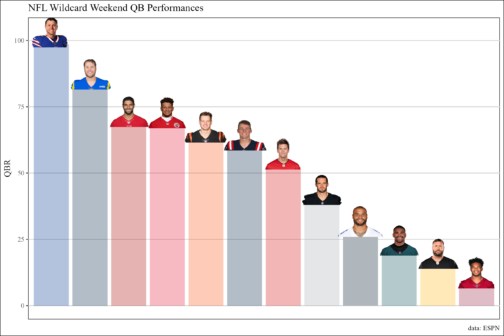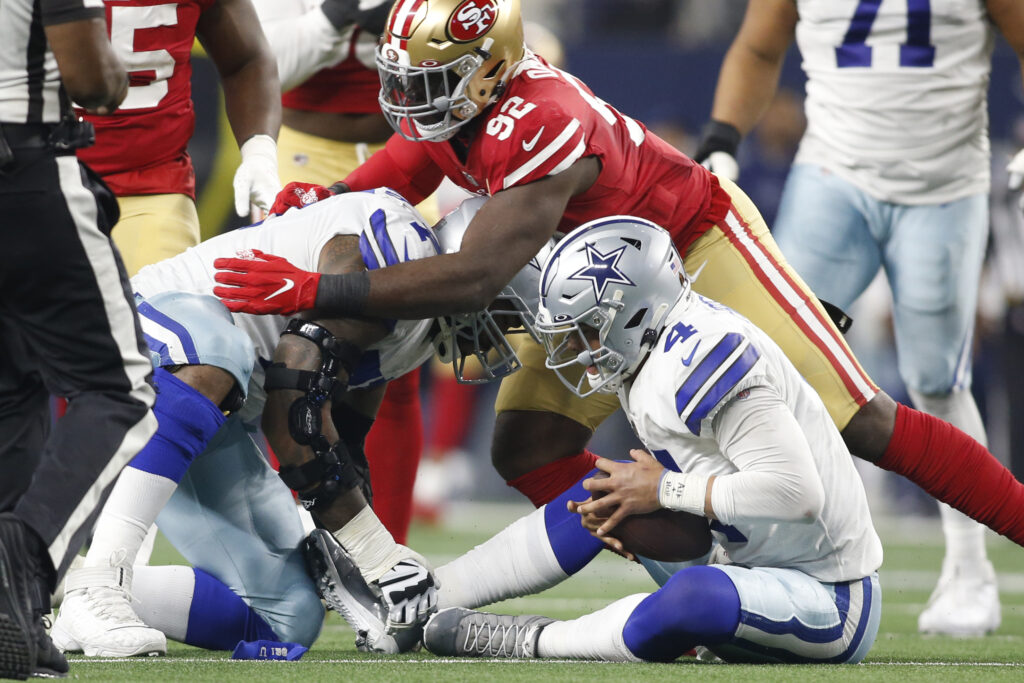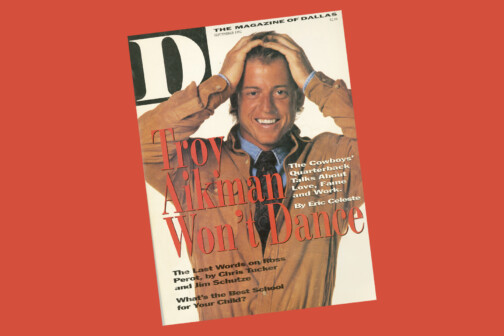What an absolute bummer of a way to end the season.
The Dallas Cowboys lost to the San Francisco 49ers Sunday—on Nickelodeon, no less—to end their hopes of a Super Bowl bid, and the vibes were off from the very beginning. San Francisco scored points on every drive of the first half, save the 22 seconds they ran out at the end of it. Dallas, meanwhile, had a much more concerning start, gaining 7 total yards in the first quarter and scored no points in the first 24 minutes. By the end of the third quarter, Dallas was trailing by 16, only managing to score points on one drive. That offensive offensive performance was the major story of this game, and it all comes down to one number: 27.0
That’s quarterback Dak Prescott’s total QBR on the day.
QBR stands for Quarterback Rating—not to be confused with the more common passer rating. It’s scaled from 0 to 100, with 50 being a perfectly average day. Dak Prescott got decidedly below-average results Sunday in the biggest game of the year. It was the fourth-worst game from Prescott this season by QBR, trailing the Broncos and Chiefs losses as well as the Week 14 Washington win.
It was, quite simply, a brutal day for the passing attack. Through three quarters of play, Prescott completed a little over half his passes and took four sacks, netting the Cowboys a grand total of 104 yards through the air. That cannot happen in a playoff game.

QBR is largely based on ESPN’s own expected points model. We’re getting deep into the initialisms here, I know, but stay with me. Expected points come from mathematical models that take into account the context of every play—things like down, distance, field position, current score, and time remaining—and putting them on a scale of actual points scored. Each play has its own expected point value; plays that improve a team’s chances of scoring earn positive expected points added (EPA), while plays that reduce the chance of scoring earn negative EPA. It’s a great predictor of team success—or in this case, team failure.
Prescott’s plays on the day added up to nearly two touchdowns worth of negative plays (-13.2 EPA), per the most common public EPA model from Ben Baldwin of The Athletic. The average play was a net negative for Dallas when Prescott dropped back to pass, but the team couldn’t avoid pass plays after falling in such a deep hole so early on in the game.
In general, pass plays earn a higher EPA on average than run plays, which makes sense seeing as how the average pass play gains about twice as many yards as the average run play. But this week, the Cowboys’ offense actually produced better offense running the ball than they did passing it. Which is a truly remarkable feat considering the running backs carried the ball 16 times for just 45 yards on the day. The passing offense generated -0.18 EPA/play while the rushing offense generated -0.12 EPA/play.
Dallas’ early struggles on offense may also help explain Mike McCarthy’s reliance on his punt team for so much of this game. The big play here was, of course, the first down pass by Bryan Anger on the fake punt in the fourth quarter. (Fun fact: Anger ended the day with a better passer rating and higher EPA/play than both Prescott and 49ers quarterback Jimmy Garoppolo.)
The play was a blast to watch, as special teams fakes tend to be, but let’s not ignore the fact that McCarthy didn’t trust his offense to convert the 4th-and-5 there with the game on the line. McCarthy was one of the NFL’s most aggressive coaches in terms of going for it on fourth downs this year, but he elected to punt in this game as long as he possibly could. The Cowboys drive immediately preceding the one with the Anger completion ended with a punt on 4th-and-2 near the end of the third quarter despite the Cowboys being down three scores.
---> SF (23) @ DAL (7) <---
— 4th down decision bot (@ben_bot_baldwin) January 16, 2022
DAL has 4th & 2 at the DAL 33
Recommendation (STRONG): 👉 Go for it (+1.4 WP)
Actual play: 🏈🦵 B.Anger punts 58 yards to SF 9, Center-J.McQuaide, fair catch by T.Benjamin. pic.twitter.com/SE8Nix0Edg
Look, I’m aware they were down 16 points, a lead that can technically be erased with just two scores, but 1) multiple two-point conversions are a far cry from a sure thing, and 2) later on in this very game, McCarthy kicked a field goal down 16, thereby admitting that it was indeed a three-score deficit. Again, would he have opted to kick that field goal or punt that ball or run an offensive play with his punt team instead of his star-studded offense if that very offense hadn’t been a shell of itself all day? The 4th-and-2 punt should be a straightforward “go for it” at that moment in the game, but maybe it’s not so straightforward when your quarterback has, up to that point, dropped back to pass 28 times and gained a grand total of 90 yards.
So many things went wrong for the Cowboys’ offense on Sunday. It wasn’t even a typically bad day where the guys are just off. Even the stadium wasn’t feeling a Cowboys win in this one.
☀️☀️☀️☀️ pic.twitter.com/9BoQn1fnjy
— Brandon Thorn (@BrandonThornNFL) January 17, 2022
And those failures on offense affect more than just the actual offensive production. They can alter play calling to the point where the team sends out the punt unit to convert a key fourth down rather than the offense. Maybe the reason the punt team stayed out after that conversion was because they were having a more productive day than the offense and Dallas thought they’d ride the hot hand.
The real takeaway from all of this is that the offense, specifically the passing offense, failed. They weren’t able to string together enough plays to score more than one touchdown for 45 minutes straight, and it cost them. If the Cowboys want to take that next step into legitimate Super Bowl contender, it starts with taking all these pieces they have on offense—the running back duo, the top-notch receiving crew and breakout receiving tight end, and the franchise quarterback—and finding a way to make them function on a consistent basis. When it works, whoa, boy, does it work. But there were too many games when it definitely did not work, and those games need to be much fewer and farther between in order to bring the Lombardi Trophy back to Dallas.
Get the ItList Newsletter
Author






